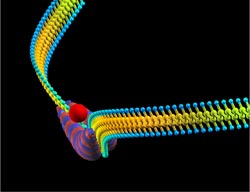Researchers have discovered evidence of an ancient sea creature that would have made Tyrannosaurus rex, think twice before stepping into the ocean.
At the southern tip of South America , they found fossils of an entirely new species of ancient crocodile – one whose massive jaws and jagged teeth would have made it the most fearsome predator in the sea.
Unlike the crocodiles we know today, Dakosaurus andiniensis lived entirely in the water, and had fins instead of legs. But
System can provide tens of seconds of warning about impending ground motion
A University of California, Berkeley, seismologist has discovered a way to provide seconds to tens of seconds of advance warning about impending ground shaking from an earthquake.
While a few seconds may not sound like much, it is enough time for school children to dive under their desks, gas and electric companies to shut down or isolate their systems, phone companies to reroute traffic, airport
New software is helping scientists get a more complete view of the environment from satellites that orbit the earth.
Maps that depict the thickness of the ozone layer, for instance, frequently contain blank spots where a satellite wasn’t able to record data on a particular day, explained Noel Cressie, professor of statistics and director of the Program in Spatial Statistics and Environmental Sciences (SSES) at Ohio State University.
He and his colleagues found

Theory could result in faster artificial muscles
Robots, both large and micro, can potentially go wherever it’s too hot, cold, dangerous, small or remote for people to perform any number of important tasks, from repairing leaking water mains to stitching blood vessels together.
Now MIT researchers, led by Professor Sidney Yip, have proposed a new theory that might eliminate one obstacle to those goals – the limited speed and control of the “artificial muscles” that perf
After five years of being the world’s largest free-floating object, the B-15A iceberg has finally broken up off Antarctica’s Cape Adare.
ESA’s Envisat satellite’s Advanced Synthetic Aperture Radar (ASAR) is sensitive to ice, and has been tracking the movement of the drifting ice object since the beginning of this year. Its latest imagery reveals the bottle-shaped iceberg split into nine knife-shaped icebergs and a myriad of smaller pieces on 27-28 October,
In searching for ways to counteract the greenhouse effect, some scientists have proposed capturing the culprit—carbon dioxide—as it is emitted from power plants, then liquefying the gas and injecting it into the ocean. But there are pitfalls in that plan.
The carbon dioxide can rise toward the surface, turn into gas bubbles and vent to the atmosphere, defeating the purpose of the whole grand scheme. Even worse, if the liquid-to-gas conversion happens suddenly, the gas can bubbl